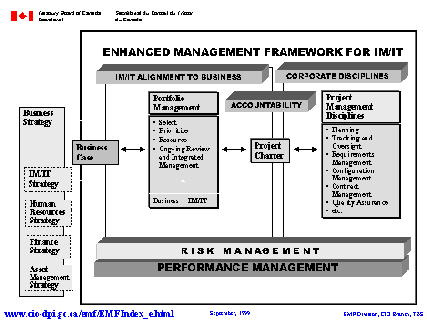Common menu bar links
Breadcrumb Trail
Institutional links
Chief Information Officer Branch
IT Project Review and Oversight
Enhanced Management Framework
ARCHIVED - Management of Large Public IT Projects - Canada
 This page has been archived.
This page has been archived.
Archived Content
Information identified as archived on the Web is for reference, research or recordkeeping purposes. It has not been altered or updated after the date of archiving. Web pages that are archived on the Web are not subject to the Government of Canada Web Standards. As per the Communications Policy of the Government of Canada, you can request alternate formats on the "Contact Us" page.
1.2 Enhanced Management Framework for IM/IT (EMF)
In 1996 the Treasury Board Secretariat developed the Enhanced Framework for the management of IT projects, which has since evolved to become the Enhanced Management Framework for IM/IT (EMF). The objective of the EMF is to help departments better manage their IM/IT projects and improve the success rate of IM/IT investments. Departments were directed to apply this Framework to all projects that have a significant information management or technology component, regardless of size. The EMF was designed to ensure that government information technology projects fully meet the needs of the business functions they are intended to support, deliver all expected benefits and are completed on time and on budget.
Subsequently the EMF has expanded from focussing solely on project management disciplines to include portfolio management, which addresses the overall management and governance of IM/IT investments. This helps improve the strategic use of IM/IT investments through a stronger alignment with business directions and priorities.
EMF enhances the government's ability to manage its IM/IT investments, successfully deliver IM/IT projects, and minimize risks. It provides for a more effective, efficient and successful management of IM/IT allowing for optimal selection of high-return IM/IT investments, balanced decision-making, comprehensive risk management and successful delivery of projects.
EMF is an integrated management model that includes processes and key practices for executives, as well as for business and project managers. The framework is supported by a set of principles, best practices, methodologies, tools, templates, handbooks, guides, and standards.

The conceptual model above shows the components of the EMF, and the way in which they are related.
EMF is based on four guiding principles:
- Alignment of IM/IT investments with business strategies;
- Establishment of clear accountabilities for managing IM/IT investments;
- Development of corporate project management disciplines; and
- Identification and management of risks on a continuous basis.
EMF addresses two broad areas: portfolio management and project management. Portfolio management stresses the importance of aligning business planning with an integrated IM/IT strategy. This strategy should set priorities and budgets for the organization's IM/IT investments as a whole, allowing it to assess and successfully manage projects, existing operations, enhancements and innovative pathfinders. Within this context, organizations should review their IM/IT investments and – based on this review and available funds – select those investments that will deliver optimal value. EMF also promotes the application of project management disciplines to all approved initiatives, as well as the implementation of risk and performance management throughout the entire process.
The implementation and the institutionalization of EMF across government is led by an Implementation Council – a government-wide partnership with representatives from 28 departments, the Office of the Auditor General, and central agency functional areas like policy, risk, audit and procurement. The EMF Division within the CIO Branch of TBS, is a centre of excellence assisting departments in their EMF implementation efforts. In partnership with the Implementation Council, it evolves the framework, rolls out well-researched solutions and toolkits, promotes and shares best practices, conducts symposia and workshops, addresses policy issues, and provides leadership, advice and support.
Alliances have been formed with leading international standard setting organizations, U.S. government agencies, professional associations, educational institutions, and central agencies. Special Interest Groups are created to facilitate sharing of experiences, best practices, and lessons learned on specific subjects and issues such as risk and process improvement. Ad-hoc working groups are set up to help develop specific solutions, including templates, tools, guidelines and methodologies.
Details on the EMF and its suite of solution sets can be obtained from http://www.tbs-sct.gc.ca/emf-cag/index-eng.asp.
Since September 1997, all new projects submitted by departments for approval by the Treasury Board Secretariat have been required to conform to the best practices in the Enhanced Management Framework. In addition, the Secretariat applied the appropriate principles from the Framework to all Year 2000 projects.
